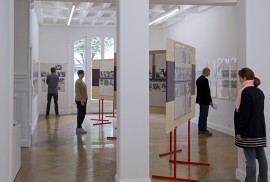The Second Sex – A Visual Footnote
In this very first sentence of Volume Two of The Second Sex, Simone de Beauvoir sets about debunking the notion of an “Eternal Feminine”, still doggedly persistent when the book was published over sixty years ago. Beauvoir continues, “No biological, psychological, or economic destiny determines the figure that the human female takes on in society; it is civilisation as a whole that produces the creature, intermediate between male and eunuch, that is described as feminine.” The book’s project was the liberation of women, but the deliberate ambiguity of its title is clear: it allots the “female” second place in a human species treated, with a certain
irony, as an animal one. A “second sex”, then, is still being defined relative to a first one, to the “male” who plays the leading, decisive role in shaping the concept of humankind. What Beauvoir is saying is that in fact there is no natural female – or for that matter male – state, and no decree of fate assigning us to one group or the other; at work, instead, are social constructs powerful enough to influence our consciousness and our bodies right down to their most intimate levels. Later, Carol Hanisch’s 1969 maxim “the personal is political” would urge taking the feminist struggle to every aspect of life, from society to the individual body. In a further extension of de Beauvoir’s thought, Anne Oakley’s 1972 distinction between sexuality (biological) and gender (culturally constructed) made it easier to recognise male-female differences as variable and contextual rather than innate and immutable.
In addition to its militant aspect, then, feminist thought is a critical practice involving a challenge to the myths that haunt our societies and a denunciation of the dominance of the patriarchal model, the pseudoneutrality of the universal, the normativity of heterosexuality, etc. It implies, too, recognition of the role of the personal and the biographical in every creative stance; and calls for a “situated” knowledge enabling the author to occupy his or her rightful place and make explicit his or her personal commitment.
While feminism is not, in theory, a strictly female preserve, this is still pretty much the case in practical terms. Which is why I was somewhat puzzled to see a man, influenced by his reading of this feminist classic, modestly volunteering to contribute a “visual note”. For me this exhibition is also the opportunity to start a feminist-inspired research project at La Galerie, in which art, seen as separate neither from the personal nor the political, is receptive to the specific circumstances of both society and its creator: art, in short, that is more than just a distanced, symbolic mirror of the world.
Émilie Renard
Translated by John Tittensor
around the exhibition
-
25/05/2013
- From 2 p.m
What is that sintaxe ? Course performed by Lætitia Paviani
—
Infos : taxitram@tram-idf.fr -
25/05/2013
from 3 p.m to 5 p.m
Workshop “Language of the body, a moment of respite?” by Marianne Wex.
-
15/06/2013
3 p.m
Discussion around the exhibition with Tobi Maier (curator in residence), Nicole Fernández Ferrer (Centre Audivisuel Simone de Beauvoir, Paris), Elisabeth Lebovici et Giovanna Zapperi (Travelling Feminist).
-
21/06/2013
from 6 p.m to 9 p.m
Seminar “Travelling Feminist” withTobi Maier and Estelle Nabeyrat (with films by Ilene Segalove).
—
At Forum des images, Paris
